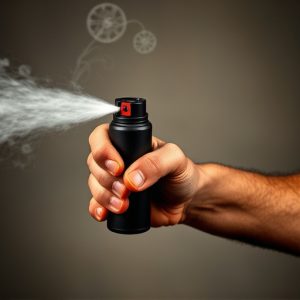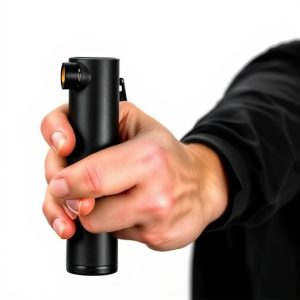Bear Spray Defense: Effectiveness in Rainy Conditions & Choosing the Right Spray
Bear pepper spray remains effective against bears in rainy conditions despite moisture, thanks to it…….
Bear pepper spray remains effective against bears in rainy conditions despite moisture, thanks to its active ingredient capsaicin which irritates bears' senses. Proper usage techniques, such as aiming for the face and deep breathing, maximize its impact in wet environments. Choosing bear spray designed for rain with wider patterns and following label recommendations ensures optimal safety during encounters in adverse weather. Regular practice and carrying spray in waterproof containers are also crucial for readiness. Remember that pepper spray is an emergency measure to deter or delay bear attacks.
“Staying safe during encounters with bears is crucial, especially in their natural habitats. In this comprehensive guide, we explore an effective defense mechanism: bear spray. ‘Understanding Bear Spray: The Basics’ breaks down what you need to know about these powerful tools. We delve into specific considerations for ‘Pepper Spray Effectiveness in Rainy Conditions’, ensuring you’re prepared for any weather. Learn how to ‘Choose the Right Bear Spray’ and discover ‘Safety Tips’ for optimal use, empowering you to navigate bear country with confidence.”
- Understanding Bear Spray: The Basics
- Pepper Spray Effectiveness in Rainy Conditions
- Choosing the Right Bear Spray for You
- Safety Tips and Best Practices for Bear Spray Use
Understanding Bear Spray: The Basics
Bear spray, also known as pepper spray, is a specialized defense mechanism designed to deter and incapacitate bears during an attack. It’s a crucial tool for hikers, campers, and anyone venturing into bear country. The key component of bear spray is capsaicin, the same chemical that gives chili peppers their heat. This substance irritates the eyes, nose, and respiratory system of bears, temporarily disorienting them and allowing for an escape or a chance to reassess the situation.
One common misconception is that bear spray is ineffective in rainy conditions. However, thorough testing has shown that water does not significantly reduce the pepper spray’s effectiveness. The aerosol can still reach and penetrate the bear’s eyes and respiratory tract, ensuring its deterrent properties remain intact even in wet environments. Knowing how to properly apply bear spray, understanding its range and duration of effect, and carrying it with you when venturing into bear-inhabited areas are essential precautions for anyone aiming to stay safe in nature.
Pepper Spray Effectiveness in Rainy Conditions
In rainy conditions, pepper spray remains an effective self-defense tool against animal attacks, though its performance can be influenced by water. Pepper spray works by irritating the eyes and respiratory system, creating a temporary yet powerful distraction for potential predators. However, moisture from rain can dilute the spray’s concentration, potentially reducing its reach and impact. Despite this, it still provides valuable time and space to escape or summon help.
Proper usage techniques, such as aiming for the face and breathing deeply after spraying, can maximize pepper spray’s effectiveness under wet conditions. It’s crucial to remember that while rain may affect the spray’s intensity, it doesn’t make it useless. In fact, knowing how to adapt its use in rainy scenarios can significantly enhance personal safety during outdoor activities or in regions with high rainfall.
Choosing the Right Bear Spray for You
When selecting bear spray, understanding its effectiveness in various conditions is key. Pepper spray, the active ingredient in many bear defense aerosols, has proven to be highly effective against bears when used correctly. However, its performance in wet or rainy environments can vary. Some factors to consider include spray pattern, droplet size, and drying time – all which influence how well the spray reaches and irritates the bear’s eyes and respiratory system.
Look for bear sprays that are designed specifically for use in wet conditions, as these will have features like a wider spray pattern to account for moisture in the air. Additionally, check the label for recommendations on usage distance and duration – crucial factors when navigating through rain or misty conditions. Remember, no bear spray is 100% foolproof, but the right choice can significantly improve your safety during encounters in wet environments.
Safety Tips and Best Practices for Bear Spray Use
When using bear spray as a defense mechanism, safety and proper application techniques are paramount. Always ensure you have a clear understanding of how the spray works and its range. Bear spray is designed to create a barrier between you and the bear by temporarily blinding and disorienting it, giving you time to retreat or fight back if needed. However, environmental factors like rain can impact its effectiveness. Pepper spray, the active ingredient in bear spray, may lose some potency in wet conditions due to evaporation. Despite this, it remains a crucial tool for deterring bear attacks, especially when used correctly.
To maximize pepper spray effectiveness in rain or other adverse weather, follow these best practices: carry it in a secure, waterproof container; check the expiration date regularly as the spray’s potency decreases over time; and practice target practice to ensure you can accurately deploy the spray when needed. Remember, bear spray is meant for emergency situations only; avoid encounters if possible by making noise while hiking, traveling in groups, and properly storing food to minimize potential targets for wild animals.
When it comes to bear spray defense, understanding its effectiveness, especially in rainy conditions, is crucial. Despite some myths, pepper spray remains a reliable tool for deterring bears, even in wet environments. The key lies in choosing the right product and using it correctly. By following safety tips and best practices outlined in this article, you can enhance your chances of staying safe during encounters with these majestic creatures, ensuring a more enjoyable outdoor experience in bear country. Remember, knowledge and preparation are your best allies when navigating through nature’s challenges.


